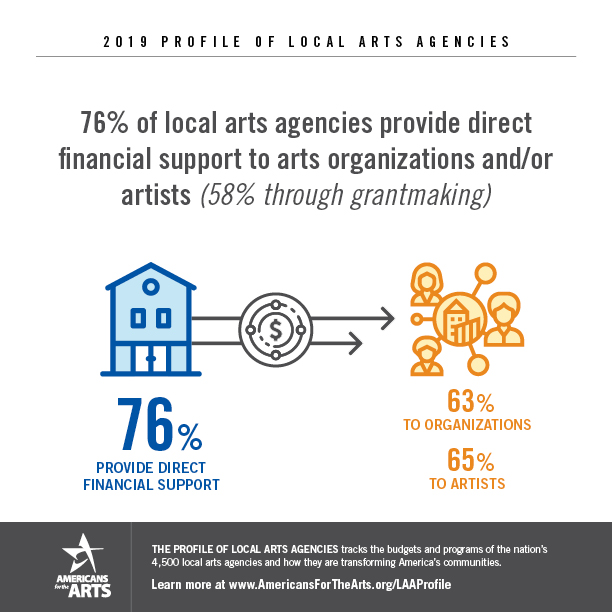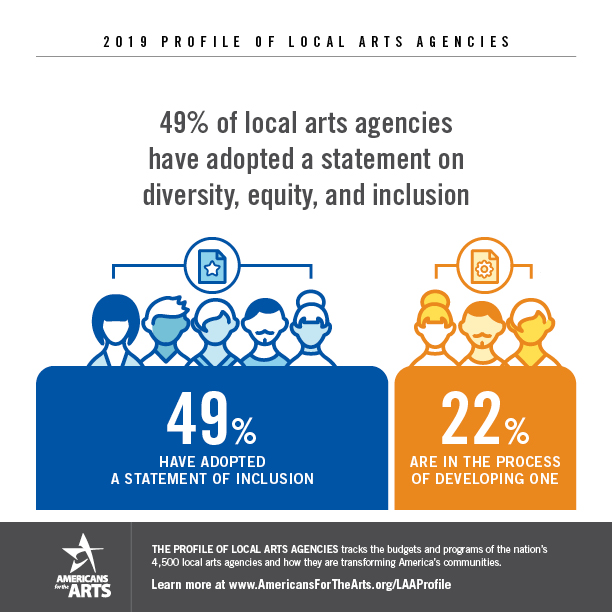Unpacking the 2019 Profile of Local Arts Agencies Study
Posted by Apr 24, 2020

Randy Cohen
During the last half century, the local arts agency (LAA) movement in the United States has flourished—with the number of LAAs growing from 400 to 4,500. They provide programs, services, and funding to strengthen their local arts and cultural sector, integrate the arts into the fabric of the community, and make the arts accessible to all. It is no surprise, then, that Americans are now more engaged in the arts than ever before, with nearly three-quarters of the adult population attending the arts and nearly half personally involved as arts makers. It is because of this vital presence that tracking the health, operations, and impact of LAAs is a matter of pressing concern.
The 2019 Profile of Local Arts Agencies is our annual survey of local arts agencies. It focuses on a core set of LAA indicators—budget trends, partnerships, programs and services, and diversity and equity policies. We supplement this with two modules that enable us to take a deeper dive into specific aspects of LAA work. This year’s modules focus on (1) partnerships with non-arts organizations and (2) local and state option taxes used to fund the arts (report coming soon). Last year we studied (1) equitable grantmaking and investment in the arts and (2) LAA staff salaries and benefits. Each module has its own separate analysis available on our Profile website.

I conducted my first LAA survey for Americans for the Arts in 1991 (we didn’t even ask for fax numbers back then). The one constant over the years is my ongoing appreciation of how LAAs evolve to keep pace with how their community evolves.
- In those early days, less than a quarter of LAAs used the arts to address community development issues. Today, that figure is 95%. Nearly every LAA provides not just cultural benefits to their community, but also social, educational, and economic development ones.
- We also see LAAs pushing themselves and their communities on issues of diversity, equity, and inclusion. Half of LAAs have diversity policies in place related to board, staff, or grantmaking. Yet, the data also reveal the challenges of the diversity of leadership—with less than 10% of CEOs being a person of color.
- Over the past decade, we’ve seen an increase in communities integrating the arts into their broader community-wide master plans—including the arts among all civic priorities. A planning data point that has remained steady, however, is that there are always about one-third of LAAs that have completed a cultural planning effort within the previous five years before completing the survey—and those that do have consistently seen greater rates of budget growth than those that don’t.

There are multiple ways to use the findings in this report. Perhaps you are looking to justify a partnership with your Chamber of Commerce? Your board will be delighted to know that about half of LAAs are already doing so. Or maybe you just want to know how your LAA budgets and programs stack up statistically against similar LAAs from across the country. For that, you’ll want to check out our online interactive LAA Dashboard, coming soon to the Profile of Local Arts Agencies website. Head over there to learn even more about LAAs, peruse our fabulous suite of reports, infographics, data tables, and online tools (all freely available!).
Because the data used for this report was collected from May through August in 2019, we need to acknowledge that the landscape has changed radically due to the COVID-19 virus in early 2020. It has already resulted in the cancelation of thousands of arts and cultural events across the country and resulted in billions of dollars of damage to our arts ecosystem. Communities that rely on a portion of hotel-motel tax funds to support the arts already are feeling the pinch, and are likely to see the impact stretch well into 2021. Given this jolt, some of the findings in this report (e.g., budget forecasts, cash reserves, and community priorities) likely no longer reflect what the LAA field is currently experiencing.

And yet, even in this devastating-to-the-arts COVID-19 environment, local arts agencies are stepping to the fore to support their arts communities in a crisis. The Greater Houston Area Arts Relief Fund is helping artists and arts workers who lost wages and opportunities because of COVID-19. In Boston, the Mayor’s Office for Arts and Culture hired an Arts and Emergency Preparedness Coordinator to promote and provide resources to support the arts during the crisis. Arts Council for Long Beach (CA) has a #KeepArtsWorking campaign. The Prince George’s (MD) Arts and Humanities Council maintains resource pages for the arts community. These are just a few of the many innovative examples of the quick and strategic responses by local arts agencies. To see more examples, visit our COVID-19 Resource and Response Center.
I would like to express my deepest gratitude to 633 local arts agencies that completed the 2019 Profile survey—an increase of almost 100 respondents from the 537 that completed the 2018 survey! We thank each one of you, as this report would not be possible without you. I also would like to express appreciation to the National Endowment for the Arts for their generous support of the 2019 Profile of Local Arts Agencies, the LAA Dashboard, and field education opportunities. Finally, to all LAA staff, board, and volunteers: Thank You for everything you do to advance the arts in America!





